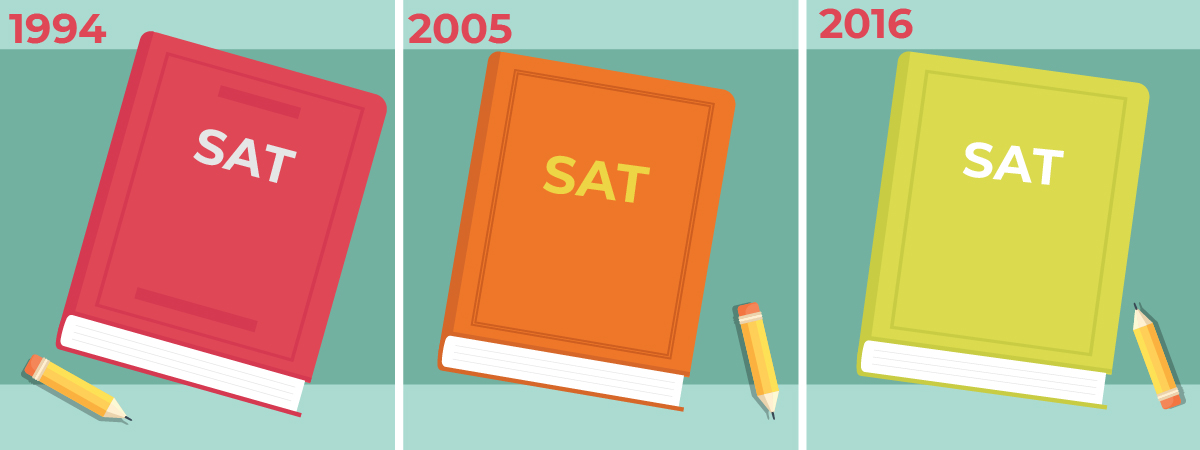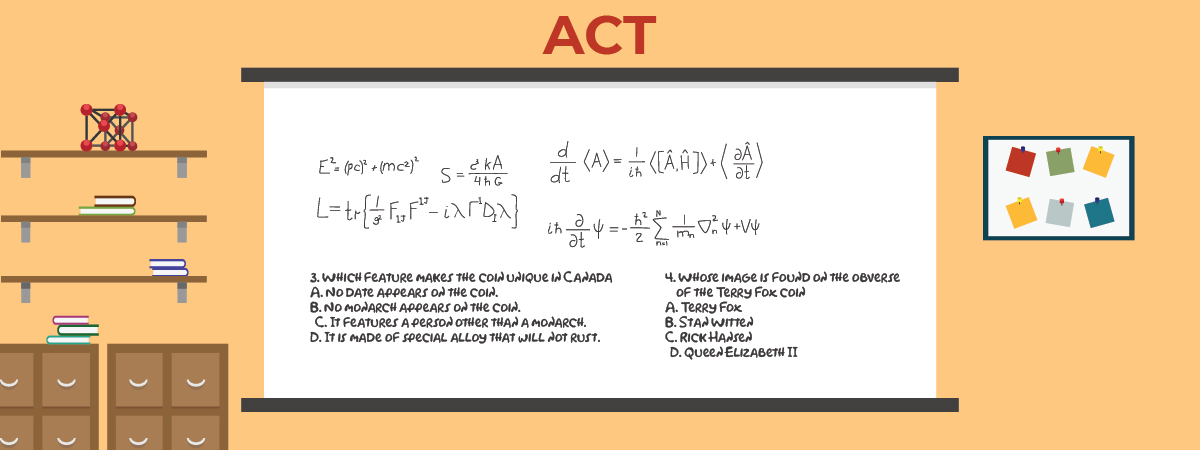SAT vs ACT: Which Exam Should You Take
Every high school student looking to attend college eventually asks themselves, “SAT or ACT?” Let’s be honest; there are a lot of factors to consider and knowing the amount of time it can take to prepare for one, you should be clear about where you want to focus. Let’s help you answer the question, “SAT vs ACT, which one to take”?
When you are ready to make your decision, we have both SAT prep and ACT prep courses available to you year-round to help.
[sat_one]

SAT: Basic History
Let’s start with how these tests got here in the first place. First on deck is the SAT.
Before the SAT, individual universities used their own in-house admissions tests, so nothing was standardized or uniform. At the beginning of the 20th century, 12 universities banded together to form the College Board.
This group then developed and implemented the first standardized admissions test for students in 1901, known as the “College Boards”. The schools involved were primarily established East Coast institutions like Columbia University and New York University. This test originally took students 5 days to complete.
A shift occurred though in 1905 when the first IQ tests were administered to people. The College Board, in return, began reevaluating its approach to vetting potential students.
Ironically, it was the US Army that played a direct role in the SAT’s development.
During World War I, the Army began administering IQ tests themselves to more than 2 million recruits. In charge of this effort was expert Carl Brigham, who went on to develop his own version of this test and administered it to students at Cooper Union and Princeton University.
After his appointment to the College Board’s test development committee, Brigham refined his own test into what eventually became the SAT. The SAT’s purpose differed from the previous College Board tests in that it was designed to measure learning aptitude versus retained knowledge.
Between 1940 and 1961, the SAT administration surged from an initial 10,000 students to more than 800,000 every year. However, after this initial boom period, the SAT has faced adversity from both charges of bias and discrimination, as well as direct competition from the ACT.

What Does It Test
In case you didn’t already know, here’s an idea of what the SAT will be seeking from you on test day.
The SAT today focuses on testing students on the knowledge and skills most commonly deemed as important for actual college success. This philosophy comes from the Common Core curriculum.
Much of the emphasis on vocabulary is on extended context and how word choice can affecting meaning, tone, and impact. The latest sections that students are currently tested on are Reading, Writing and Language, and Math.
The Essay section is still included, except it is now entirely optional. However, this is deceptive because many schools will still want to see an Essay score during the admissions process.
Moreover, in terms of college preparation and future success, the Essay provides students a chance to work on the kind of long-form writing that is expected on term papers, work projects, etc. in the future. Getting practice earlier, rather than later, is always a good idea.
[sat_two]

Recent Changes
Like life itself, the SAT has gone through many changes over the years.
The SAT has been under constant revision since the very beginning. The first version had 9 sections, 2 Math, and 7 Verbal, covering concepts like “Antonyms” and “Arithmetical Problems”. Within the first decade, a number of these sections were immediately dropped. In more recent times, major revisions were made to the test in 1994, 2005, and 2016.
The 1994 version removed antonyms, as well as improved the reading passages to better reflect the kind of material students would realistically encounter in college. More importantly, calculators were finally allowed to be used on the test.
The 2005 revisions famously eliminated the dreaded analogies-driven questions and introduced a 2400 point scale, alongside a required essay section. The most recent changes in 2016 were seen by many as a means to directly compete with the ACT, by making it more ACT-like in design and spirit.
For example, the instituted 2400 scale was removed and replaced by the previous 1600 point scale. The once required essay now became optional. Also, the previous point penalties for guessing were eliminated, fewer overall questions are asked, and there is now a higher emphasis on data analysis.
A major criticism of the latest version is its apparent reliance upon the Common Core curriculum, which many have argued eliminates the development of critical thinking and creativity in favor of straightforward linear analysis and extrapolation. What is certain for high school students is that the SAT will continue to change in response to the times that it is administered.

ACT: Basic History
Now that you have a basic introduction to the SAT, let’s move onto its counterpart, the ACT.
First launched in 1959, the ACT (originally referred to as the “American College Test”) was designed to be a direct competitor to the SAT. The test itself was designed by Iowa education professor Everett Franklin Lindquist and was derived from the Iowa Tests of Educational Development.
Where the ACT originally differed from the SAT was its focus; the ACT was designed to test students on their knowledge retention versus reasoning skills. Rather than asking a student how they would figure out a problem, the test taker is required to demonstrate what they know in certain areas instead. Another interesting side note – the ACT was the first standardized test that included a Science section; previous tests had inquired about mathematics but never science.
The first ACT was administered to over 75,000 students in 1959. The original subjects tested on were English, Mathematics, Natural Sciences, and Social Studies – already a simplified alternative to the SAT’s antonyms and other more esoteric concerns. Each section was timed for 45 minutes to complete.
An important factor in the ACT’s early adoption boiled down to geography – the test proved incredibly popular in the Midwest and the central United States for college admissions boards. Why? Because the SAT, despite being around for over 20 years longer, was primarily used by institutions in the northeast.
Part of the ACT’s purpose was to provide an alternative for public universities and colleges to use for admissions because the SAT was relegated mainly to selective schools in the Northeast. Because of this selectiveness, the SAT did not establish enough foothold in other areas of the country, leaving room for a competitor like the ACT to firmly establish itself.

What Does It Test
Let’s start to see how the ACT differs from the SAT by looking at its main focuses first.
The ACT test is designed to assess a student’s skills in five specific areas: English, Math, Reading, Science, and Writing (now optional). The idea is to measure a student’s general development in these core areas and assess their readiness for handling entry-level college assignments in each of those subjects.
This emphasis on “college readiness” is a factor that immediately differentiated the ACT from the SAT in terms of focus. However, just like the SAT, the ACT has been changed and refined over the decades while maintaining these core goals.

Recent Changes
Again, just like the SAT, the ACT has been revised and updated to make it relevant to today’s students.
In 1989, a major overhaul took place which saw a number of significant changes. The original ‘Natural Science’ section was replaced with ‘Science Reasoning’, to shift some focus to analytical and problem-solving versus only knowledge retention.
The original ‘Social Studies’ section was removed and replaced with “Reading”. The test also dropped its questions about US History, within the Social Studies section, and changed gears to focus on reading ability and comprehension. The Math section added trigonometry and pre-algebra into the mix.
In the English section, grammar was de-emphasized in favor of general writing skills. In 2005, the ACT added an optional Essay section to further compete against the SAT essay at that time. The most recent changes to the 2016 version included broadening the Math and Science sections, and revising the Writing section by increasing the possible points and making the prompts broader in nature.

Major Features
Both tests have similar content sections overall, but the detailed differences between them are important to know before making your choice.
The SAT, in its latest version, is broken down across 4 sections (3 mandatories, 1 optional): Reading, Writing and Language, Math, and the Optional Essay.
In the Reading section, 52 questions cover content shared within five long passages. Of those passages, two of them cover a related topic. In terms of passage subjects, there is a mix of History and Social Studies, alongside some Literature and Science. Each passage covers 10 to 11 questions.
The Writing and Language section is comprised of one major set of questions, 44 in total. Those questions are a mix of passage-based and grammar-based material. In terms of the passages themselves, here is the general breakdown: 1 careers passage, 1 history/social studies passage, 1 nonfiction narrative passage, 1-2 argument passages, and 1-2 information/explanatory text passages.
The actual skillsets these questions probe are grammar & usage, rhetorical skills, and data interpretation. The emphasis on data interpretation and nonfiction analysis can be traced back again to the Common Core-inspired revisions, a framework many schools follow that emphasizes practical preparedness for college and career afterward.
The SAT Math section has shrunk in terms of actual size overall, but greatly expanded the range of subjects tested than before. Reduced from 3 sections to 2 in the latest version, the Math section presents students 58 questions – 45 multiple choice questions and 13 student-produced response questions. Calculator usage is allowed; however, unlike the previous version which allowed calculator usage everywhere, this version has a set of questions where calculators are prohibited.
Again the range of subjects has been expanded, staying in line with the Common Core-inspired changes. The tested content includes Arithmetic, Algebra & Algebra II, Geometry, Coordinate Geometry, Data Analysis, Statistics, Probability, Trigonometry, and additional Geometry material not covered on the previous test.
The Essay section is meant to mirror a regular college class writing assignment, emphasizing how to break down and analyze a given text. The student receives a passage to read and is then tasked with explaining how the author constructed their argument to persuade the reader. The student must then support their explanation by citing the evidence found in the passage itself.
Students have 50 minutes to complete the Essay section, if they so choose, which is double the time previously available to do so. Moreover, the student isn’t asked to agree or disagree with the author’s position or write about their own personal experiences.
The ACT is broken down into 4 required sections: English, Math, Science, and Reading. In addition, there is an optional Essay section that students can complete.
The English section is comprised of 75 questions that students have to answer within a 45-minute timeframe. The questions test for grammar, punctuation, style, sentence structure, organization, and overall strategy. In terms of structure, students need to be ready to tackle multiple-choice questions covering usage and mechanics, as well as rhetorical skills.
The Math section presents 60 questions that need answering within 60 minutes. The questions test for students’ proficiency in elementary algebra, pre-algebra, intermediate algebra, both coordinate and plane geometry, and trigonometry. Structurally, students need to blow through a variety of multiple-choice questions covering these various topics.
The Reading section is shorter with only 40 questions to answer but within a 35-minute time frame. Questions measure reading comprehension in two ways – what is actually stated and what is implied. More multiple-choice questions are presented to students.
The Science section also presents 40 questions to be answered within a 35-minute period. In terms of content, the following areas are explored – data analysis and interpretation, evaluation, reasoning and problem-solving. The questions themselves are a mix of multiple-choice inquiries asking about data representation, conflicting viewpoints, and summarizing research.
The Writing section contains the now-optional Essay that one can elect to do. In this case, you tackle an essay prompt and use it to demonstrate your overall writing skill and comprehension of related skills.

Major Differences
Now that you know what to expect from each one, let’s start looking at what makes them different.
The quickest way to start identifying major differences between the SAT vs ACT is to break them down via the categories listed below:
Time Management: If you need those precious extra seconds to think about an answer before writing it down, then the SAT may be the better fit. Why? Because, on average, the SAT gives you more time per question to answer than the ACT:
- Reading: ACT – 53 seconds, SAT – 75 seconds
- English (ACT) /Writing (SAT): ACT – 36 seconds, SAT – 48 seconds
- Math: ACT – 60 seconds, SAT – 75 seconds (w/out Calculator), 87 seconds (w/ Calculator)
- Science: ACT – 53 seconds, SAT – N/A
In general, every SAT section allows for more time that the ACT per question for answering. In some areas, such as Math, the differences are substantial. On the whole, the SAT allows you at least a good 10 to 20 seconds more of time to answer every question per section. That could be the difference between figuring out that last equation step or having enough time to choose between the right answer amongst the wrong ones.
Science Questions: If you are naturally good at, or are interested in, Science-related subjects then the ACT has an entire section that covers that material alone. This isn’t to say that the SAT doesn’t have any Science questions on it; there are some, however, they tend to be scattered throughout other sections like Math and Reading.
For example, you may be presented with a question that contains a data chart and are asked to analyze the presented evidence. However, these questions are not in abundance on the SAT. If Science is a stronger suit for you, then choosing the ACT, where you can show off your knowledge, is definitely worth considering.
Calculator Usage: If you prefer solving as many Math problems as possible with a calculator, then it’s important to know that the SAT instituted a specific-No Calculator subsection on its latest revision. Keeping that in mind, that section has only 20 questions, which are designed to be manageable to answer without a calculator.
Also, remember that, on average, you have more time to answer Math questions on the SAT than ACT. However, if you don’t want to mess around with working out solutions long-hand, then the ACT lets you use a calculator on every single question. The trade-off is you have less time to answer every question overall, so even with calculator help, you need to think and answer faster on that test.
Tested Math Concepts: Sticking with the Math section, if you’re good at Algebra inside and out but aren’t as strong in other areas like geometry, then the SAT may be a better fit. Why? Because the ACT Math section is heavy on testing various concepts, some that the SAT doesn’t even touch at all.
For example, on the ACT, geometry takes up between 35 to 45 percent of the questions asked. In contrast, the SAT focuses less than 10 percent on the same material. Trigonometry takes up around 7 percent of the ACT but less than 5 percent on the SAT. Then there are concepts that the SAT doesn’t even touch like logarithms that will show up on the ACT.
In short, if you like Algebra and straightforward data analysis then the SAT will fall into your strengths. But, if you’re better at other concepts like geometry and trigonometry then the ACT will fit better. Again, assess where your strengths are and pick the test that displays them better.
Formula Reference Guide: Have your Math formulas memorized? If so, then the ACT will fit like a glove. For students who aren’t as ready, the SAT provides a Math Formula Reference Guide that you can use before tackling each subsection. There are a few caveats to remember: the formulas themselves will mostly involve geometry concepts, which are already very light on the SAT.
Second, it is always helpful to have some formulas memorized because constantly referring back to the guide will take up precious seconds you may need to answer other questions. However, you still are provided with a resource that the ACT itself doesn’t have at all on test day.
Math Score Weight: The biggest factor you should consider when comparing Math sections is how much weight your Math subscore will have on the final composite score. On the ACT, despite being more intensive content-wise, the Math subscore only comprises 25 percent of the final score.
On the SAT though, because of how the test sections are organized, the Math section comprises 50 percent of the final composite score. That means Math carries literally twice the weight on the SAT vs ACT.
Long story short, if you are competent but not entirely confident in your Math skills and knowledge, the ACT is the better test to take. Because each subscore will affect the final composite, which determines your percentile ranking, one low score could scuttle your chances of getting into the highest possible percentiles.
[leadmagnet_two]
Evidence Citation and Chronological Questions: How good are you at analyzing text and finding the exact phrases and information needed to support your argument? Citing evidence is a major component of the SAT Reading section, where questions often refer back to each other and require you to cite specific lines of text in the passages provided to justify your answer.
The ACT doesn’t stress this skill in its comparable Reading section. Another thing to be aware of is that the SAT Reading questions flow in a chronological manner, meaning that parallel the passage’s flow. ACT Reading questions do not follow a passage’s flow and are much more random.
The benefit of chronological questions though is they allow you to cut down on time when referring back to the passage itself. ACT questions will force you to review the entire passage constantly, instead of knowing which section to go to immediately.
Essay Focus: The Essay section on both the SAT and ACT remain optional, however, there are still differences between the two regarding how to approach it. On the SAT, where data analysis and evidence citation are important, you read the provided passage and then dissect the author’s argument by analyzing the text, providing examples, etc. The focus though is purely on analysis.
On the ACT version though, you will read a passage, examine the presented topic, analyze the differing perspectives, but then also add your own opinion too. If you’re comfortable with analyzing and breaking down a presented argument then the SAT format will suit you well. However, if you prefer to simply compare and contrast perspectives while formulating your own, then the ACT will fit better.

You’ll Like SAT If…
The SAT will fit you well if the following list resonates with you.
Don’t Like Skipping Questions: On the SAT, because of the increased time allotment per question, chances are good that you can at least attempt every single one. This time limit is not a guarantee that you will answer everything correctly. But you can at least try as long as you’re working at an efficient pace. Conversely, it’s normally assumed that most students won’t complete the majority of questions on the ACT unless they’re likely to score a 30 or above.
Don’t Like Time Limits: As was discussed earlier in the post, the SAT does, on average, allow more time to answer questions than the ACT. Remember though that despite the time increase, SAT questions are often more difficult than their ACT counterparts. Moreover, if you’re someone who panics under pressure or has trouble trying to move through a lot of material quickly, then the SAT may be a better fit on test day.
Don’t Like Geometry: If you’re not strong at geometry, then chances are good that you won’t like the ACT. Why? Because it features three times as many geometry questions as the new SAT. Also, you have the luxury of geometry equations being included on the reference guide before the section begins. On the ACT, you better have everything you need to be memorized.
Don’t Like Science: Let’s be clear, both the SAT and ACT have science questions. But the ACT dedicates an entire section to science alone. The SAT sprinkles its own science questions throughout the other sections, but not as heavy as the ACT. If you struggle with science-related questions or concepts, then you have a better shot with the SAT format.
Like Writing Analysis: The SAT essay section will ask you to read and break down a presented piece of writing, not unlike a regular English class. You won’t be required to form and express your own opinion. If picking writing apart is a strong suit, but crafting your own argument isn’t, then the SAT essay will better showcase your strengths.

You’ll Like ACT If…
The ACT may be more your style though if the following list speaks to you more.
Don’t Like Challenging Vocabulary: The SAT was notorious for its vocabulary selection, especially with its analogy questions. Students needed to have a deep resource of obscure words, in order to have a chance to do well.
Thankfully, those questions were removed years ago; but the test itself still employs fairly difficult vocabulary on its reading and writing sections. The ACT is known to have a more approachable vocabulary and has easier questions overall on its reading section versus the SAT.
Don’t Like Citing Evidence: The SAT is big on evidence citation questions now, meaning having to go back and point out specific lines in a reading passage in order to justify your answer to a previous question. So instead of facing questions as entirely independent, you have to constantly cross-reference between them and justify your answers sequentially. If this seems like a waste of time and energy to you, then realize this is not a worry on the ACT.
Always Need A Calculator: The latest SAT version includes a no-calculator subsection in its Math section. While this section doesn’t really require you to do highly complex calculations, the fact remains that if you have trouble doing math fast in your head or don’t have enough time to write out every step, then those questions will create trouble. The ACT again won’t require you to give up your calculator while taking it.
Don’t Like Similar Questions In Different Sections: One trend on the new SAT is to constantly test specific skills, no matter the section. For example, quantitative reasoning questions aren’t just tested in the math section; they also show up in the reading and writing sections too.
This is in line with the new test’s focus on verifying those aforementioned skills more than knowledge. However, the ACT keeps everything in their places overall; this is little to no mixing of similar questions across different sections. So if you don’t want to worry about math questions in a reading section, then the ACT will fit well.
Like Forming Opinions: When it comes to the essay section, the ACT and SAT have opposite viewpoints. The SAT is all about analysis and evidence, taking an author’s presented argument and breaking it down logically. It does not require your own opinion on the subject itself. But if you like forming and sharing your own opinion, then the ACT essay allows you to do so when writing it.

Which One Should You Finally Take?
Ultimately, the decision on which test to take is yours alone but consider the points below to help.
If you’re interested in showcasing your knowledge in a variety of areas, then the ACT’s design will let you show off that strength. However, if you enjoy to show off your skills rather than knowledge, than the SAT is better suited to do so.
Remember this key point, the test you choose should be the one that shows off, and plays, into your strengths the best. The reason being that those strengths are what will help you get the score you want, and show admissions officers what your strengths and weaknesses are too when assessing your application.
If you have any specific questions about which one is better for you, then don’t hesitate to contact Prep Expert’s enrollment team and ask. We can help you figure out the right one to take and provide the resources and strategies needed to get the highest possible score. Don’t wait until it’s too late to find the right test for you.
[sat_three]
For more test strategy, college admissions, and scholarship application tips sign up for our FREE class happening right now!
Written by Dr. Shaan Patel MD MBA
Prep Expert Founder & CEO
Shark Tank Winner, Perfect SAT Scorer, Dermatologist, & #1 Bestselling AuthorMore from Dr. Shaan Patel MD MBA

How to Get Into Stanford: Breaking Down Stanford Admission Requirements in 2024
Applying to college is overwhelming no matter what schools are on your list, but you might find yourself sweating a…

Why DEI is Destroying Meritocracy and How MEI Can Save Us
In recent years, Diversity, Equity, and Inclusion (DEI) initiatives have become a cornerstone of many corporate and educational policies. While…

Should I Take an SAT Prep Course?
If you’re getting ready to take the SAT soon, you might be wondering whether or not you should enroll in…